The Alarm Strength – An Oral History [Part Four – Finding Strength, Hope and Love In The Studio]
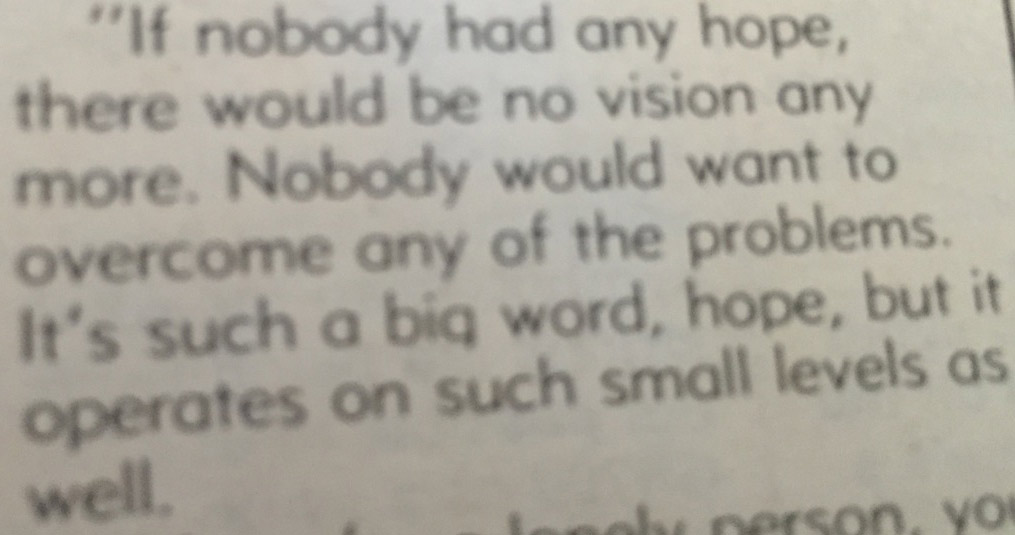
“We are on our own now, we’re not part of a movement nor are we a band that will turn round and have an out-and-out pop career. We don’t write music for the sake of it. I like to think we write because we’ve got something to say.” – Mike Peters 1985
After the success of ‘Absolute Reality’ and the positive reaction towards the new songs performed on the ‘Absolute Tour’, the Alarm felt extremely confident going into the studio to continue the work they had already started with producer Mike Howlett and recording engineer Nigel Luby.
-Dave Sharp “Innerview” with Jim Ladd, 1986
June 6th 1985 The Alarm and Mike Howlett moved into Marcus Recording Studios, located just off Westbourne Grove in Bayswater, London at 49-53 Kensington Gardens Square a week later.
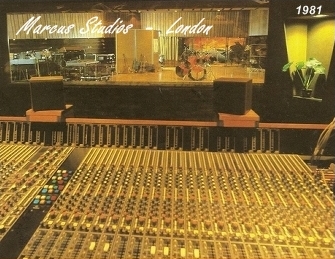
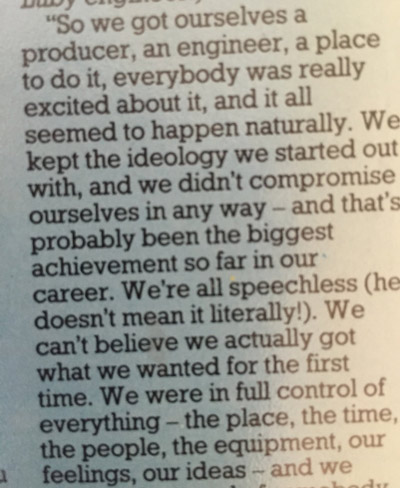
“What has been getting to me is something that Eddie said. He said, instead of writing songs about the whole world, why don’t you write about your own world, because everything that happens in the world happens in your little corner of it too.” – Mike Peters 1985“I’ve been in the position of having no money, but I come from quite a good background. My Mum and Dad are not rich but they own a shop and get by. I had a good job in computers – this was in 1975 – and I could have stuck at it and been part of what is the boom industry of today. I didn’t want it though, l wanted to be in a band and be a “rock’n roller”. I refuse to believe that young people cannot rise above their station in life. I believe if you want something badly enough you can get it, because I’ve done it. I think there’s a place for everybody in this world and there’s somewhere for everyone to go. Most people are sold the dream that getting to the top is the be all and end all of life. But it isn’t. I’m not blinded by the desire to be the biggest rock star in the history of the world. I am more concerned to nurture friendships outside the band. I am ambitious to improve the songwriting and performance of the band because of the personal pride in doing something well.” – Mike Peters 1985
“Lyrically, “Strength” is a much more personal album than its predecessor. The band freed me from the responsibility of having to reflect the collective feelings of the band and encouraged me to reveal the more personal side of my nature. ‘Spirit Of ‘76’ was a lyric I was very aprehensive about at first as it is autobiographical in the extreme. During the punk rock era of 1976 to 1977, every weekend, me and my friends would cross the Mersey River from North Wales into Liverpool to Eric’s club in Matthew Street, which was opposite the sight of the old Cavern Club, the birthplace of the Beatles. In fact, the steel door entrance to Eric’s was directly below an iron Beatles statue inscribed with the legend “John, Paul, George and Ringo – Four Lads Who Shook The World”. From 1976 to 1977, Eric’s was a remarakable scene to be a part of. Every weekend, we’d see the most amazing bands, meet even more amazing people and nearly every member of the audience was either in a band or thinking of starting one. Echo & The Bunnymen, Frankie Goes To Hollywood, Lightning Seeds, Flock Of Seagulls, O.M.D., Icicle Works and many others were all part of the same scene. One of the first people I met there was Pete Wylie who went on to front his own band Wah! Heat. Pete actually sold me a copy of his first single “Better Scream” while we chatted on Matthew Street one Saturday afternoon. (The Alarm modelled the sleeve layout of ‘Unsafe Building’ on Pete Wylie’s gatefold sleeve). Pete Wylie was the first person I ever met who actually did “see his dreams come true”, he went on to have many hit records in the U.K. with his band Wah!. I first heard the title “Spirit of ‘76” in its wider concept of American independence, but to me it spoke of the true spirit of Punk Rock, of hope and optimism and growing up in North Wales with my friends and remembering, “all the promises all the dreams we shared.” – Mike Peters
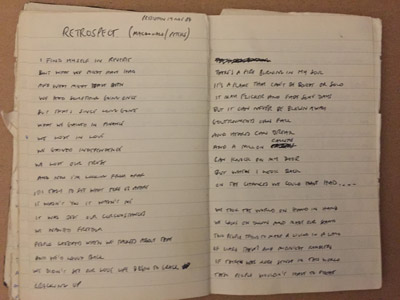
– Original draft lyric for ‘Spirit Of ’76’ [Working Title – Retrospect] from Mike Peters note book 1984-1986.
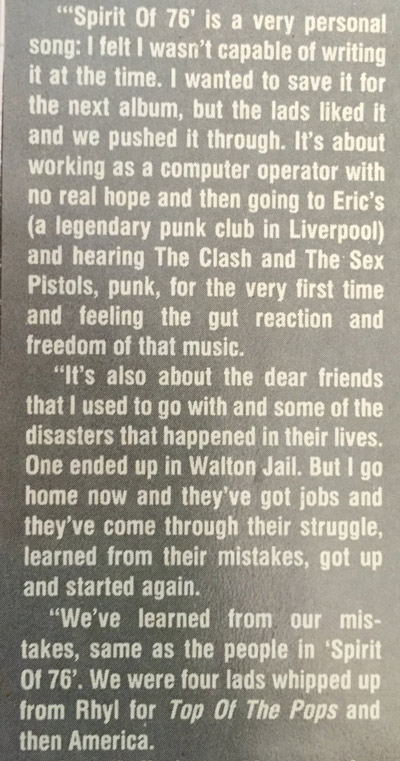
“With punk rock I decided there was nothing for me where I lived. The first place I ever tried to get anything going was in Liverpool at Eric’s Club. That’s where I met Pete Wylie. Everyone in Rhyl tended to head to Liverpool. Eddie, myself and Twist would go there – there was a scene. Dave would go when he was home from the navy. And then Eddie, myself, and my friend Red Eye tried to create the same scene in Rhyl which we called The Gallery but that was destroyed by violence. That was the spur that told us we’ve got to get out of this place, and so we moved to London.” – Mike Peters 1985
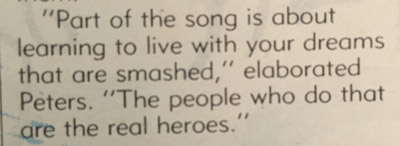
“After the reviews and critical mauling we received on “Declaration” we were fighting for our lives and we knew it. We were skint, bruised and battered. “Strength” brought us back down to earth with a bang, and Mike’s lyrics reflect the time and atmosphere perfectly. Overall, I think the songs were as strong as “Declaration” but very different. It must have been tough on the fans as all the albums were very different from each other, the only constant factor was Mike’s vocal presence.” – Eddie Macdonald
“Born of Janice Joplin and Bruce Springsteen, Bono was the Preacher, Bob Dylan christened them” you know the quote from Gary Bushell. It’s very difficult to emerge from this. It hurts me and especially Eddie.” – Mike Peters 1985
‘I enjoyed the recording sessions for “Strength”, I used to go to the gym in the morning, record drums in the afternoon and get paid for it.’– Nigel Twist
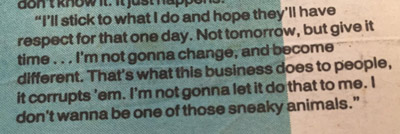
“It was actually a combination of Jimmy Iovine and Bono who suggested that I write more personally. Songs which did not make the album were “Sons Of Divorce”, “Unbreak The Promise”, and “Black Side Of Fortune”. “Majority” in its earliest lyrical form did not make the album.” – Mike Peters 1985
“Much of the time I felt the pressure to write songs for the band and that’s why I would always say it’s “we” this and “we” that, when really, and I have to thank Eddie for this, I could better say what I really felt. lt’s been so important to write down on paper and admit that I’m a lonely sort of person. It was such a relief to write “Dawn Chorus” – you know, I lived that song to write it – and to get up on stage and sing it really helped me relax as a person, on stage as well. So the person on stage is much closer to me now. I think many people were confused by this difference. lt was difficult, with the press for example, the business of politics and The Alarm I found confusing, and belief in God. Now I am coming to terms with it and starting to take a responsibility because it is easy to run away from things, and that I can’t do.” –Mike Peters 1985
‘The songs on ‘Strength’ were OK. The best was ‘Dawn Chorus’. – Nigel Twist
“I read an awful lot in the first part of last year and then seemed to stop, but I’ve started again recently. Stuff like Richard Llewelyn and Alexander Cordel, Welsh writers, you know, “How Green Was My Valley”. I’m trying to rediscover my roots, if you like. Reading these books has awoken an interest in the history of Wales.” – Mike Peters
“The song “Deeside,” on the band’s latest I.R.S. album, “Strength,” laments the loss of the steel industry in Wales.” -CHERYL WENNER, The Morning Call Friday, March 14, 1986
“The mills closed down in 1977 at the same time England had a recession, so the summer resort season, which you can normally count on to last about 12 weeks, lasted about three. It really hit home. The fact that no one realized it was coming softened the blow, but, unfortunately, people realized it was coming after they’d bought the new fridge and the new television,” – Eddie MacDonald
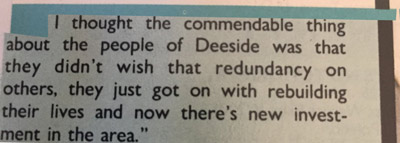
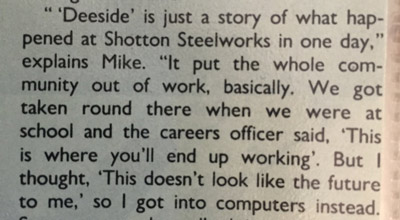
“I think Deeside is the best song Mike Peters and I ever wrote together.” – Eddie Macdonald
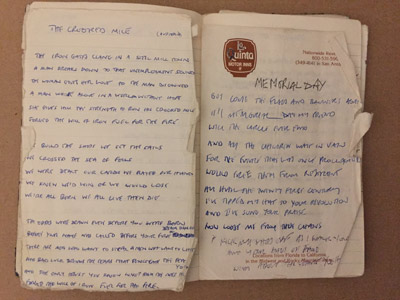
– Original draft lyric for ‘Deeside’ [Working Title – Crooked Mile] from Mike Peters note book 1984-1986.
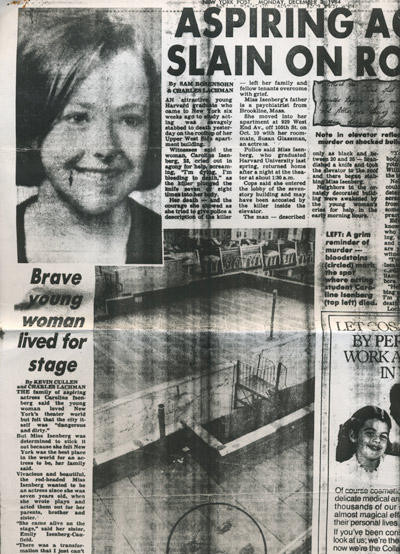
‘Whilst we had been in New York in September 1984, I came across a story in the New York Post about a young actress named Caroline Isenberg, an aspiring actress who had been murdered on her way home from auditions in Manhattan. Although I never knew Miss Isenberg, I was moved to write a lyric based on her tragic story. I cut a demo version of the song with Twist, who worked up a drum pattern on the synthesiser we had brought in to create the opening to the title song ‘Strength’, it was mixed and then forgotten about. When we came to release ‘Knife Edge’ as the third single from the album, IRS needed extra tracks for b-sides. We were in the U.S. on tour and sent them a message to dig out the mix of “Caroline Isenberg” from the vaults. When Steve Tannett of IRS went to the tape library to look, all he could find was the unmixed master reel. Unperturbed, he decided to book into a studio and do his own mix, which was eventually released as a b-side in 1986. When I eventually got to hear the single and listened to the b-sides (probably in a record shop, as IRS never used to send us finished copes of our own records….), I realised Steve, who had not heard the original arrangement had wrongly assumed Twist’s drum track should be in from the beginning. He had mixed the track with the wrong arrangement. When I was doing the research for the “Strength” remaster in 2000, I finally came across the “lost” master mix of the correct arrangement from 1985, amongst some “Strength” album out-takes.’ – Mike Peters
Jun 29, 1985 The Alarm Croke Park, Dublin
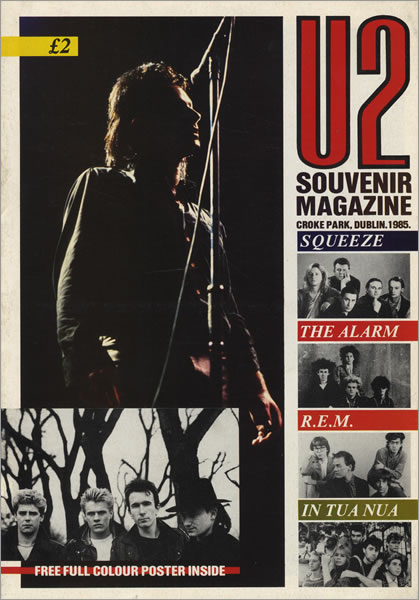
Neil Storey – How important a gig was Croke Park, Dublin, to you? You played to 60,000 people and the vibe was extraordinary. In Tua Nua came on and did well; then REM, who didn’t die but didn’t do justice to their worth on record; and then you. You didn’t just go the whole way to the back but you went up both sides of the stadium. You exploded; the whole place just went mad. What did it fee! Like? How important was it?
Mike Peters – It was just incredible although, you can’t just do it without the back-up of great songs. We are capable of writing more songs that can come to life in the big gigs. The show just sent shivers down my spine. For me the day was encapsulated in what I said from the stage, ‘two years previously I had been in Dublin at Phoenix Park pogoing at the front to U2, and here today I’m on U2’s stage playing’. You see, everybody really wants to be in the band, and the better the band are, the better it is for the crowd. It’s the best feeling I have ever had at a gig. It’s hard to say what goes through your mind, but the feeling of peace is incredible.
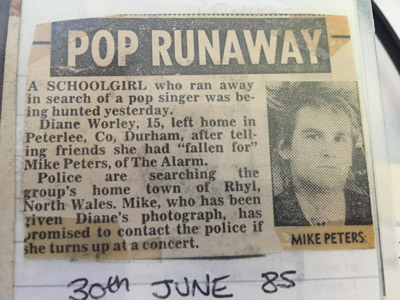
July 3rd 1985 Bruce Springsteen & The E Street Band, Wembley Stadium
“Back in September of 1984, I’d been taken by Alarm manager Ian Wilson to see Bruce Springsteen on the Born In the USA Tour at the Spectrum in Philadelphia. It was a life changing concert. Ian had seen him in Meadowlands, New Jersey a few weeks earlier while he was setting up the Pier show and probably decided it would be good for my musical education to see him. I was blown away by the wealth of musical styles Bruce and the E Street band covered in concert from small acoustic intimacy to full on raging rock and roll power aligned with the subtlety and humour of his story telling and the pathos and power of his message. It really was an influence and probably the spark to write something on a grand scale. The original date for the first draft of ‘Spirit Of ’76’ is witness to the fact that the song began after seeing Bruce Springsteen.” – Mike Peters
“While we were recording the album, the Born In The USA tour came to Wembley Stadium and I went to see all three shows (we were on Premier Talent in the USA the same concert booking agency as Bruce Springsteen and so had access to the guest list) – Mike Peters
July 4th 1985 Bruce Springsteen & The E Street Band, Wembley Stadium
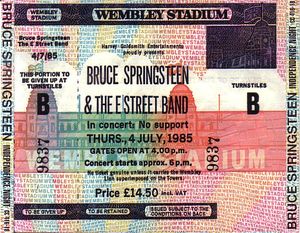
“During the July 4th concert, I met Gary Tallent at the interval between sets. Gary came up and said that Bruce, Little Steven and he were fans of the Declaration album and so I invited him to the studio to hear what we were up to.” – Mike Peters
July 5th 1985 Gary Tallent the bass player from Bruce Springsteen’s E Street Band drops by the studios.
“I couldn’t believe it. Gary Tallent from the E Street band just ambled into the studio. He was very humble and stayed for quite a while and gave myself and the band a lot of encouragement and advice. It was Gary who told us that Bruce Springsteen donated the PA system (used at his own three concerts), to Bob Geldof and the promoters of Live Aid.” – Mike Peters
July 13, 1985 Live Aid, Wembley Stadium

“We had played some University Ballroom shows in early 82/83 with the Boomtown Rats and we got to know Bob Geldof reasonable well during the proceedings as he was always playing practical jokes on us while we were on stage, or driving home from the shows in the mini bus. One day in the late autumn of 1984, Redeye and I bumped into Bob Geldof on the Kings Road in London, we stopped for a chat and I asked him where he was going? In reply, he told me that he had “just seen an incredible documentary about famine in Ethiopia and the terrible effects it was having on the population”. He said he was “going to see Midge Ure (Ultravox), to work on a song to release as a potential Boomtown Rats charity single to help the plight of the starving people in Africa”, I remember wishing him well and offering to help, if he should ever need any, before he jumped into a passing taxi. The rest as they say is history.” – Mike Peters
“There was some talk about The Alarm playing at Live Aid, we certainly wanted to be part of it, but I think Bob Geldof or Harvey Goldsmith (The UK Promoter), adopted a policy of only having artists who had achieved number one status in the singles or album charts as the benchmark for qualification. I’m not sure if that was strictly true or ever officially enforced but that was the word that was coming out and in truth it probably helped as a way of politely turning down every single act in the world that suddenly wanted to be a part of it once it became clear how big an event it was going to become. I went along on the day and volunteered to help as a steward helping people find their seats. I went with Redeye and Gareth ‘Gaz Top’ Jones (our old roadie who was by now, a well known Tv presenter on British Television). We had an amazing day and word soon spread that we were in the stands. Television pictures even picked us out during Bob Geldof and the Boomtown Rats performance.
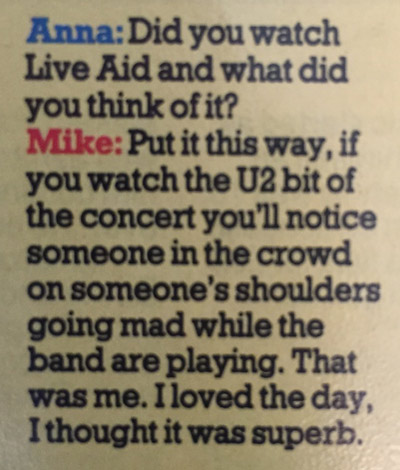
“In 1985 I was sixteen and really into The Alarm. Really, really into them. My copy of Declaration was completely worn out and I was desperate for the new album, Strength, to be released. I spent all my money going to Alarm gigs which were just the best incredibly sweaty, bouncy, religious singalongs. I’d managed to get on the Bruno Brookes show to ask the band about the Poppy. On everything I owned I drew the exploding Red Poppy. The eighties had been dominated by the Falklands War and the Miners strike. For me the exploding Poppy symbolized excitement, energy, love and above all optimism. I didn’t want to go to Live Aid. None of the bands I liked were gonna be there. I couldn’t understand why Bob Geldof had not asked The Alarm. Spandau Ballet, Nik Kershaw and Howard Jones was not my idea of a good time. But my sister, Ruth bought me a ticket and told me it would be good as U2 were on the bill. I decided that it was my duty to represent The Alarm at the show which was to be broadcast live all day on TV. I spent a few careful hours painting my Poppy onto an old sheet. So much cooler than Ruth’s green U2 flag. We nicked a couple of canes from Dad’s veg patch and flags in hand hitchhiked the 150 miles south from Retford to London. Live Aid was amazing. Wembley was a huge boiling vat of optimism. Like being at a giant Alarm gig. We were at the front all day but then just before Jack Nicholson announced U2 people started pushing to the front. Turning to complain to the next bloke who tried to push past us I had to laugh when from under a baseball cap I saw it was Mike. Perched on Gaz Top’s shoulders Mike was grinning from ear to ear as he waved to U2 up on the stage. I remember thinking this was a pretty good second to the Alarm actually playing. Hitchhiking home the next day we bought a copy of The Sunday Mirror. It was full of stories about the greatest show on earth. Across the center pages was simply a close-up photo of the Wembley crowd. On one side a pretty girl on someone’s shoulders and my Poppy Flag on the other. I imagined the photo editor was an Alarm fan too.” – Joe Derrick Alarm Fan
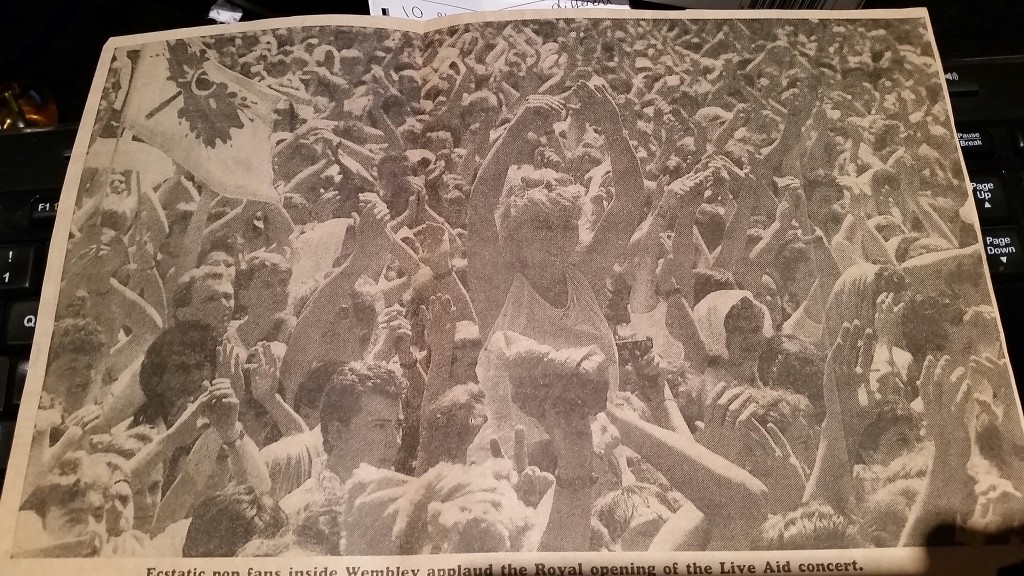
“Someone had brought an Alarm Red Poppy Flag to the event and it was flying all through the day and you can see it on the TV pictures during every artists performance. We went down onto the pitch to say hello to the bearer but U2 came out onto the stage at the same time and the place went wild, and so rather than going back to our station in the stands, we stayed and watched from the pitch. It was during ‘Bad’ that I was hoisted up onto Gareth’s shoulders and you can see me on the broadcast while Bono and the band were on stage.” – Mike Peters
It was in the run up to U2’s appearance at Live Aid that the Edge dropped by to visit The Alarm.
‘We had a few disinguished guests come to visit during the sessions, The Edge (U2), who had been staying at an apartment nearby and Roger Daltrey (The Who). Roger was a fan, who had previously been to see us at Hammersmith Palais in 1984. He had also included “Where Were You Hiding?” in his all-time Top 10 on a BBC radio programme and came to the studio with Alan Shacklock to see how we were getting on. He said to me that he “really liked the song Eddie and I had written for him”, but that it had got to him too late. and he had already committed to the songs for ‘Under A Raging Moon’. I can remember him clearly saying that he was looking forward to hearing more from The Alarm particularly after we had “weathered a few storms” as he said that the challenge of writing from adversity is what he believed made Pete Townshend the writer he was. Looking back I think he was trying to give me give me something to think about for the future, something to prepare me for the time when the spotlight turns elsewhere” – Mike Peters 2015
“The most important song that Eddie and I had heard from the band since the beginning was “One Step Closer to Home”. We first really heard that when we did a Radio 1 Session for Kid Jensen. This was approached by the band differently from the sessions we had done before. Instead of using all the instruments of the band turned up loud, we did this one acoustically with just one guitar. Eddie and l worked up “Walk Forever By My Side” and “Unbreak the Promise” while Dave played “One Step Closer to Home” which we’d never heard before. He recorded at the microphone in one take and we were swept away. Eddie was inspired to write several songs as a direct result of hearing it”.- Mike Peters 1985
In concert, ‘One Step Closer To Home’ was already a classic with the fans. During the sessions at Marcus, the band cut an electric backing track, but during the overdub stage, Dave Sharp failed to get a vocal take he was happy with and so decided to leave ‘One Step’ off the album. An incident involving Jimmy Page (Led Zeppelin) during the ‘Strength’ sessions, may have had a bearing on Dave’s inability to sing his masterpiece. Page, who had booked upstairs into Marcus Studio Two in order to mix a ‘live’ Firm album, came down to visit The Alarm in Studio One. When he went back, he took Dave Sharp with him for a ‘listen’.
“Then came Jimmy Page, who brought a whole different vibe into the room with him. As guitarists, Dave and Jimmy soon started talking instruments and soon they went into the live room where all Dave’s guitars were kept. Jimmy Page picked one up and started playing, I got the engineer to roll tape and we made our own secret bootleg of Jimmy Page playing Dave Sharp’s stratocaster, it sounded brilliant, even in tuning the instrument you could recognise his style.’ – Mike Peters
Later on, Dave Sharp went up to hear what Jimmy Page was doing in Studio Two. Apparently a bottle of whisky was offered and that was that, Dave Sharp stayed drinking with Jimmy Page for three days straight. ‘They never even left the studio, when they ran out of booze, Jimmy Page would send out for more. When Dave Sharp finally came back to Studio Two, we asked him what had gone on, he just said “Rock and roll man, ROCK AND ROLL.” – Mike Peters
The Alarm were supposed to have finished recording and mixing the album by the end of July at the latest in order to keep up the momentum created by ‘Absolute Reality’ (which had put the Alarm back in the UK charts and fostered the subsequent success of the Absolute Tour). Also, IRS Records now had a brand new worldwide distribution deal in place with the powerful MCA Records and Alarm manager Ian Wilson wanted to release a single from the sessions as soon as possible.
‘Strength’ (the song), had emerged as the main contender for lead single and it was prioritised to be the first track mixed when the band and production team moved in to Battery Studio 4, in Willesden, North London on August 5th 1985.
To further speed things up, it was also decided to mix ‘Majority’ as the b-side but, by August the 2nd when the album was supposed to be finished, The Alarm were still laying down new tracks.
“On the absolute tour I wrote a new song called “Strength”. We kept playing it in the sound checks and got a great buzz from it. In fact it’s likely to be the new single from the album. We had a show in Newcastle which was a fantastic experience. We were all so high after that show. I went back to the hotel but I couldn’t sleep for this song going through my head. I crept down to the tour bus in the middle of the night and got my guitar, wrote the chorus and worked on it some more in Manchester. When we got home after the tour I wrote the lyrics until it was finished.”– Mike Peters 1985
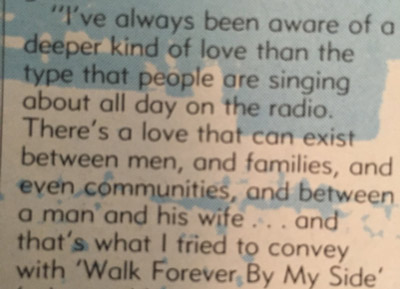
“I wrote the song back in 1983, while I was still at Emu Road in Battersea, Redeye used to play “Atmosphere” by Joy Division over and over. I’m convinced “Walk Forever” was subconciously influenced by hearing Ian Curtis vocals, day and night for weeks on end. It has since become a wedding song for many fans all over the world.” – Mike Peters
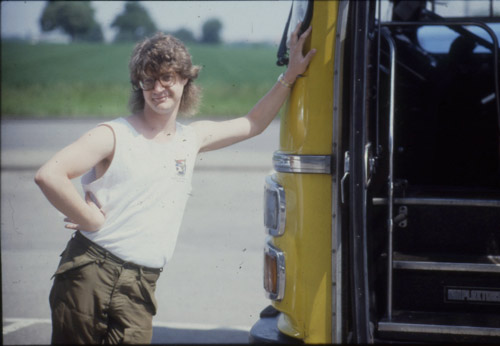
‘During the “Declaration” tour of 1984, we had guested on a huge North American tour with The Pretenders. We became great friends with Rupert Black who was playing keyboards for Chrissie Hynde and co. In 1985, we invited Rupert to play on “Walk Forever” and “Spirit Of ‘76” at Marcus Studios. Eddie Macdonald (who could play a little piano himself), would outline the basic part and Rupert would then expand and work it through to completion adding his own personality to every note he played. – Mike Peters
Eddie Macdonald had booked his wedding date for August 3rd, which was supposed to coincide with the original scheduled finish date of August 2nd. However, instead of enjoying the build up to his big day with his intended – Sharon, he was busy supervising the recording of ‘Walk Forever By My Side’, which involved a brass band score conceived by music arranger Dave Bitelli and Eddie Macdonald (who like his father before him, had once been a trombone playing member of The Rhyl Silver Band).
While Eddie was preparing to be betrothed, the rest of The Alarm were in the studio finishing ‘Majority’. (On the master tapes, the 3 mixes of ‘Majority’ are labelled as follows: ‘Wedding Day Mix 1’, ‘The Honeymoon Starts Mix 2’ and ‘The Honeymoon Flight Mix 3’. Upon completion the band went straight to the church to join in the celebrations. They only just made it on time.
‘The recording of the album was done in two stints, firstly at the Roundhouse and next at Marcus. The whole session was due to finish two weeks earlier. It ended with me working until 6.00 am on the morning of my wedding day.’ – Eddie Macdonald
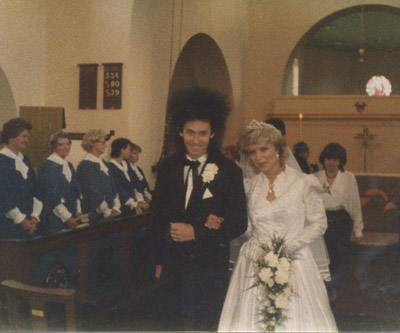
August 5th 1985 Battery Studios, Willesden, London (formerly known as Morgan Studios).
While Eddie was away on honeymoon, the band, Mike Howlett and Nigel Luby settled into Battery studios to mix the album proper, starting with the song already earmarked for the next single ‘Strength’.
“We were persuaded to record an album on the first version of digital without knowing that in its early inception, there were still various pitfalls and teething troubles. I feel that we would have been far better off recording the album on analogue rather than digital because the first part of the record was recorded at Roundhouse Studios in Chalk Farm, London. I feel the sound of the record was a much fatter and truer sound than the sound that appeared on the finished article. Strength was an album of strong songs showing good variation and consistency and I’m really proud of the material. But to sound like a broken record, I feel that the finished version didn’t live up to its potential.” – Eddie Macdonald
Two weeks later with a running order completed, ‘Strength’, the album was ready for release.
“Eddie MacDonald was very disappointed in the final mix. Jimmy Iovine would probably have used Shelley Yakus who he worked with on his Springsteen/Tom Petty records and this may have put a different slant on some of the tracks. It still sounded good though and was one of The Alarm’s most enduring albums, especially in the USA.” – Mike Peters 1985
‘The first time I heard the album mixed was on return from my honeymoon. As soon as I heard the drums at the start of “Knife Edge” I knew I was about to hate my second Alarm album. I think as a songwriter this is the cross I must bare. Once again I thought the production let it down. I think with a stronger production the album would have had far more impact. I believe the response from the “Strength” tour backed up my argument. That was amazing.’ – Eddie Macdonald
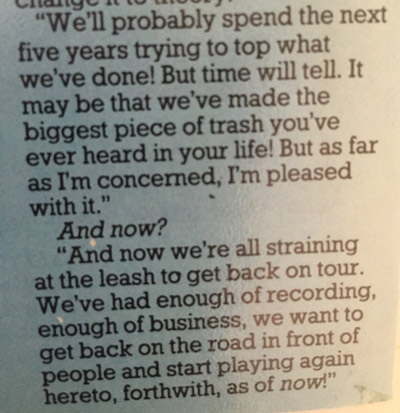
Come back to the alarm.com tomorrow for the continuing story of Strength – An Oral History……. ‘Strength’ the single is finally ‘unleashed’ and with second album finally out in the record stores, the band hit the road in the USA and bring 1985 to a close with an eventful winter tour of the UK – finishing on high at Glasgow Barrowlands on December 24th.
Strength – An Oral History. Created by Steve Fulton and Mike Peters ©2019 www.thealarm.com
Special thanks to Lee Aherne for newspaper cuttings.
Strength 1985 – 1986 is released on Friday March 15th 2019 and is available in CD / LP and Download versions with a host of previously unreleased exclusive tracks across all formats.
Strength 1985-1986 is also available to pre-order at various international retail outlets.
